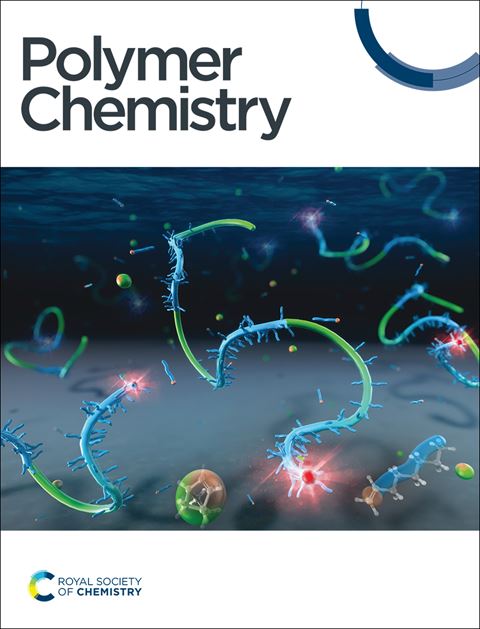结构-性能关系指导酰基氨基脲基材料的动态性能
IF 4.1
2区 化学
Q2 POLYMER SCIENCE
引用次数: 0
摘要
二次相互作用,如氢键或相分离,可以提高动态共价材料的稳定性,而不影响所需的动态性能。在这里,我们研究了基于酰基氨基脲(ASCs)的动态共价材料中多个二级相互作用的组合,目的是实现可调的材料性能。采用实验与理论相结合的方法研究了不同ASC取代基对ASC衍生物动态共价和氢键能力的影响,发现其中一个衍生物存在2个方向的协同氢键相互作用。不同的基序随后在聚合物材料中实现。将ASC基序与聚二甲基硅氧烷骨架结合在一起,引入了聚合物材料中结构依赖的有序纳米相分离。这些材料的热机械性能与氢键结构和ASC键的确切性质密切相关。整体动力学表明,键交换取决于从ASC模型化合物获得的解离速率,以及这些材料中二级相互作用的强度。ASC基团氢键结构的差异也导致材料抗蠕变性能的差异。有趣的是,具有强、有序、协同的氢键团簇的材料表现出最高的抗蠕变性能。我们的研究结果表明,通过分子设计调节动态共价材料的解离速率和二次相互作用对于控制其热稳定性和抗蠕变性是重要的本文章由计算机程序翻译,如有差异,请以英文原文为准。

Structure–property relationships to direct the dynamic properties of acylsemicarbazide-based materials†
Secondary interactions, such as hydrogen bonding or phase separation, can enhance the stability of dynamic covalent materials without compromising on desired dynamic properties. Here, we investigate the combination of multiple secondary interactions in dynamic covalent materials based on acylsemicarbazides (ASCs), with the aim of achieving tunable material properties. The effects of different ASC substituents on the dynamic covalent and hydrogen bonding capabilities were investigated in a small molecule study using a combined experimental and theoretical approach, and revealed the presence of cooperative hydrogen-bonding interactions in 2 directions in one of the derivatives. The different motifs were subsequently incorporated into polymeric materials. Combining ASC motifs capable of strong, multiple hydrogen bonding with a polydimethylsiloxane backbone introduces structure-dependent, ordered nanophase separation in polymeric materials. The thermo-mechanical properties of the materials reveal a strong dependance on the hydrogen-bonding structure and exact nature of the ASC bond. The dynamic behavior in bulk shows that bond exchange depends on the dissociation rate obtained from ASC model compounds, as well as the strength of the secondary interactions in these materials. Differences in hydrogen-bonding structures of the ASC motifs also cause differences in creep resistance of the materials. Interestingly, the materials with strong, ordered and cooperative hydrogen-bonded clusters show the highest creep resistance. Our results demonstrate that tuning both the dissociation rate and the secondary interactions by molecular design in dynamic covalent materials is important for controlling their thermal stability and creep resistance.
求助全文
通过发布文献求助,成功后即可免费获取论文全文。
去求助
来源期刊

Polymer Chemistry
POLYMER SCIENCE-
CiteScore
8.60
自引率
8.70%
发文量
535
审稿时长
1.7 months
期刊介绍:
Polymer Chemistry welcomes submissions in all areas of polymer science that have a strong focus on macromolecular chemistry. Manuscripts may cover a broad range of fields, yet no direct application focus is required.
 求助内容:
求助内容: 应助结果提醒方式:
应助结果提醒方式:


